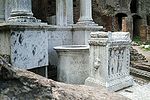Temple of Vesta

The Temple of Vesta, or the aedes (Latin Aedes Vestae; Italian: Tempio di Vesta), is an ancient edifice in Rome, Italy. The temple is located in the Roman Forum near the Regia and the House of the Vestal Virgins. The Temple of Vesta housed Vesta's holy fire, which was a symbol of Rome's safety and prosperity. The temple's most recognizable feature is its circular footprint. Since the worship of Vesta began in private homes, the architecture seems to pay homage to the architecture of early Roman homes. The temple used Greek architecture with Corinthian columns, marble, and had a central cella. The surviving structure indicates that there were twenty Corinthian columns built on a podium fifteen meters in diameter. The roof probably had a vent at the apex to allow smoke to release.
Excerpt from the Wikipedia article Temple of Vesta (License: CC BY-SA 3.0, Authors, Images).Temple of Vesta
Via di San Teodoro, Rome Municipio Roma I
Geographical coordinates (GPS) Address Nearby Places Show on map
Geographical coordinates (GPS)
| Latitude | Longitude |
|---|---|
| N 41.8917 ° | E 12.4862 ° |
Address
Forum Romanum
Via di San Teodoro
00184 Rome, Municipio Roma I
Lazio, Italy
Open on Google Maps











